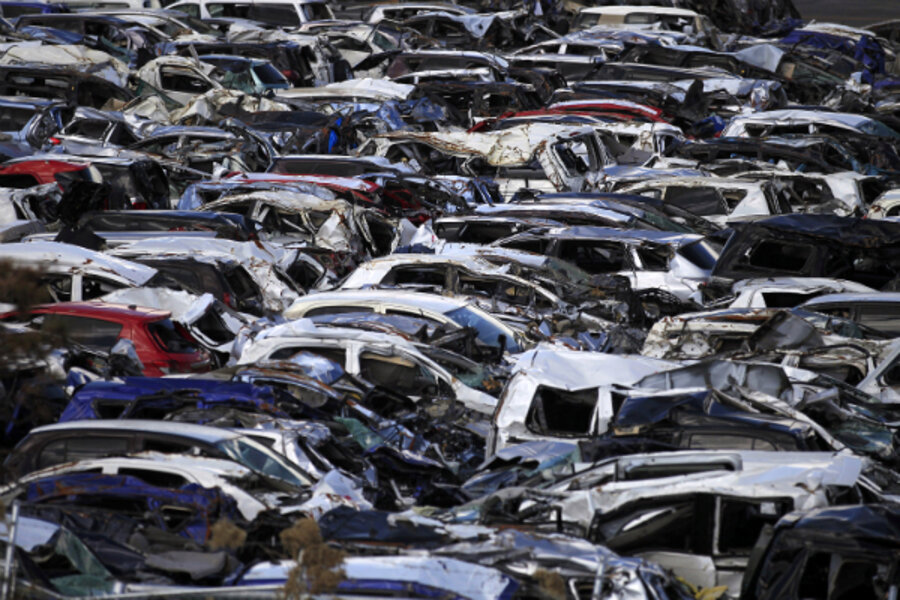Cars after Japan's quake: Toyota, Nissan, and Honda plan to restart production
Loading...
| Tokyo
As every car owner knows, it only takes one missing part to bring a car to a screeching halt. And the average car contains anywhere from 20,000 to 30,000 parts, many of which – even in American-made cars – come from Japan.
As disaster-hit Japanese automotive manufacturers and parts suppliers struggle to resume operations, the global auto industry hasn't quite come to a standstill, but it is suffering losses in production of hundreds of thousands of vehicles, amounting to billions of dollars.
"We’ve already seen production at GM, Ford, Renault, and Peugeot being disrupted,” says Christopher Richter, a Tokyo-based auto analyst for the Hong Kong-based CLSA investment group. “The auto supply chain is a bit like a house of cards; and there are going to be some surprises popping up in the form of sudden shortages down the line.”
Still, despite the huge difficulties the industry is facing, analysts say automakers like Toyota, Nissan, and Honda will be able to recover in the year ahead.
“You’re going to see some very busy plants working all the shifts they can manage to try and get back on track later in the year,” says Mr. Richter.
Though companies say they are focusing on simple recovery, analysts point to the fact that companies are restarting plant production work so quickly after such a major disaster as evidence of a healthy bounce back.
Toyota
Toyota, the world's largest car maker, had already been trying to recover from world-wide product recalls over the past year, when the 9.0 earthquake and subsequent tsunami struck Japan on March 11 knocking out power for large swathes of the country. It alone has lost production of at least 200,000 cars this month in Japan as a result.
Out of nearly 70 models, only three at two plants remained in production. Another 16 factories remain offline, including the popular Prius along with two other hybrids from its luxury Lexus brand. The majority of Toyota and Lexus assembly plants will not be operational until mid April due to shortages of fuel, supply line disruption, and power shortages.
“Even the cars that are being made, production is running on a day-to-day, almost car-by-car basis, because of parts shortages and supply-line problems,” says Paul Nolasco, a spokesperson from Toyota’s Tokyo offices.
“We’ve announced our working schedule for next week, and beyond that, nobody can say yet what is going to happen,” says Mr. Nolasco.
In spite of the production problems, Toyota has said that given the continuing extreme hardships faced by so many disaster victims, it is inappropriate to talk about the size of financial losses it has incurred.
Nissan
Nissan, Japan’s second-largest automaker, estimates its loss of production to be around 55,000 vehicles.
“Nissan has an engine plant in Iwaki City, which is in the earthquake zone and it suffered some very serious damage,” says Mitsuru Yonezawa from Nissan’s global headquarters in Yokohama, just south of Tokyo. “It’s a little inland from the coast though, so it didn’t get hit by the tsunami and there were no injuries. We’re aiming at having the plant back running at close to full capacity by the end of April.”
Until now, Nissan's factories have remained open as they were able to use auto parts they already had in their inventories, however, Mr. Yonezawa says the company is closing down all production from April 4 to 8 "to take stock and assess the situation.” Nissan has announced that its domestic auto assembly work should begin again in mid-April at reduced output levels
“For now, our main focus is to recover from what has happened, it’s not practical to be thinking about making up for lost production,” says Mr. Yonezawa, who concedes that the threat of ongoing power shortages also remain a challenge.
Both Nissan and Toyota say they have thus far managed to avoid major disruption at their overseas manufacturing facilities, though Toyota has asked its North American dealers to limit part-replacement orders to those that are “critically needed” due to impending shortages of components from Japan.
Honda
Honda’s R&D centers in Tochigi Prefecture were on the outskirts of the area worst affected by the earthquake, and one worker was killed and 16 injured by walls and ceilings that collapsed.
The company has announced major cuts in its production across its North American assembly lines, with some factories set to reduce output by more than half, though nobody is saying how long this may continue.
Out of the big three, however, Honda might suffer the least in the long term.
It estimated a loss of 46,000 vehicles due to the disaster and ensuing four-week shut down of plants, but Honda has said it expects all of its production plants in Japan to be running by April 11.
Just in time
The problems the companies face are exacerbated by the famous "just-in-time" system of production, which keeps minimum levels of parts – from windshield wiper blades to the complex micro control units – in stock at factories and aims to only restock those parts at the last possible moment. Pioneered by Toyota, and now adopted so widely it has become global best practice in many industries, the system is extremely efficient – until a problem arises with supplies.
Despite the criticisms that have been leveled at this process, it appears unlikely to change.
“Quite simply, if you’re not just-in-time, you’re not competitive,” according to Richter. “You can’t run a system that’s inefficient 19 years out of 20, just because it won’t let you down in the one year you have a major natural disaster.”
Richter believes that's why the current globalized manufacturing system will also remain fundamentally unaltered.
“The reason there is a global supply chain is because it’s the cheapest way to make cars," says Richter. "No company can try and move away from that as it will make them less competitive.”





